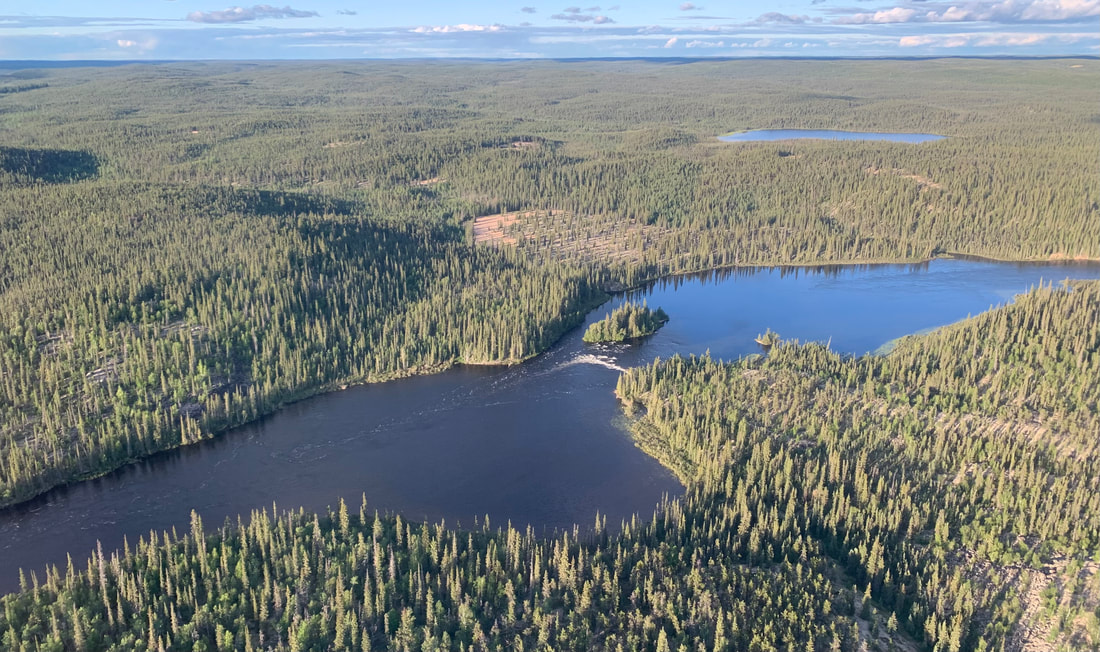Snowdrift River
The Snowdrift River is located to the southeast of Łutsël K’é. It feeds into Tthe Kálı̨ka Tué (Stark Lake), and then into Tu Nedhé (Great Slave Lake). It continues to be an important place for food gathering, community celebrations, and private cabins.
Along the riverbanks, there are constant reminders of the nomadic history of our ancestors. Homesteads can still be seen, along the river and beside Austin Lake, where many of our grandparents and parents were born. Ancient pathways follow the course of the river to rich hunting grounds upriver.
The lower Snowdrift is particularly magnificent. Our stories tell us about an old Dene woman referring to the last 30 kilometres of the river as where the water "falls down the mountain." Here, the river tumbles over falls and through canyons over the MacDonald Fault, an ancient rift along the southern boundary of Thaidene Nëné .
During the summer of 2012, the lower Snowdrift was descended by kayak for the first time by John Blyth and Ben Linaker, showing that this could be a feasible whitewater kayak trip.
The river valley is an important area for trapping fur-bearing animals such as marten, lynx, wolverine, and otters, and a rich area for hunting muskoxen, caribou, bear, and moose. Changes in climate and human activity have caused animal populations to fluctuate each year around the river: muskoxen now seen along the MacDonald Fault were not historically present, and are believed to have migrated southwest from the barrenlands in search of more food.
There are many important fishing areas along the Snowdrift, especially where it flows into Tthe Kálı̨ka Tué, and at the first set of falls. Families set nets, changing the position of nets to catch different species depending on the season. Lake trout, whitefish, and ciscoes can be found in the Snowdrift.
Along the riverbanks, there are constant reminders of the nomadic history of our ancestors. Homesteads can still be seen, along the river and beside Austin Lake, where many of our grandparents and parents were born. Ancient pathways follow the course of the river to rich hunting grounds upriver.
The lower Snowdrift is particularly magnificent. Our stories tell us about an old Dene woman referring to the last 30 kilometres of the river as where the water "falls down the mountain." Here, the river tumbles over falls and through canyons over the MacDonald Fault, an ancient rift along the southern boundary of Thaidene Nëné .
During the summer of 2012, the lower Snowdrift was descended by kayak for the first time by John Blyth and Ben Linaker, showing that this could be a feasible whitewater kayak trip.
The river valley is an important area for trapping fur-bearing animals such as marten, lynx, wolverine, and otters, and a rich area for hunting muskoxen, caribou, bear, and moose. Changes in climate and human activity have caused animal populations to fluctuate each year around the river: muskoxen now seen along the MacDonald Fault were not historically present, and are believed to have migrated southwest from the barrenlands in search of more food.
There are many important fishing areas along the Snowdrift, especially where it flows into Tthe Kálı̨ka Tué, and at the first set of falls. Families set nets, changing the position of nets to catch different species depending on the season. Lake trout, whitefish, and ciscoes can be found in the Snowdrift.

